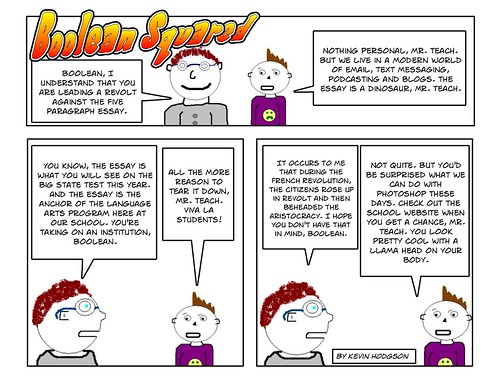I could use the extended metaphor of a torrid romance with a sexy bad boy to describe my experience with technology this semester, but that might a bit overblown and, some might argue, a product of my students’ obsession with Team Edward vs. Team Jacob. Zombies are also trendy right now, but I don’t think brain is equipped to fashion that metaphor right now.
So, let’s get to it.
As I finish up this semester I’ve had some hits and misses. If you’ve read some of my other posts this year (and I know, they have been few and far between. New school, new challenges, new excuses), you’ll know that I approached my classes with year with a kind of outlook that can only be described as naively optimistic. I saw rainbows and puppy dogs everywhere I looked. I assumed my students would be putty in my hands because they were digital natives and I GOT them. So, in summary:
Stumbling blocks:
- I didn’t consider that other members of the staff might resent the fact that two English classes were scheduled in a computer lab every day when access to computer labs is already at a premium. Not my fault, but it didn’t really matter.
- Although my students are digital natives, they were not all tech-savvy
- Although most of my students use social networking sites and web 2.0 apps on a regular basis, a number of them balked at using these tools for educational purposes
- Many students were opposed to sharing their work (even though many of them are okay with showing inappropriate pictures on facebook!)
- Some of my students have adopted anti-technology positions in, what I can only assume is, a desire to please authority figures who condemn technology as frivolous or non-academic.
- Paper: I still need paper for some things, and for some reason I feel like I’m being judged as a bad teacher if my students don’t have any paper handouts. I’m working on it.
- Oh, and apparently I adopt every new tool that interests me.
Now, for the good news:
- Some of my students changed their minds. I had a student tell me that initially, he was “creeped-out” by edmodo, because he didn’t really understand what it was. He is a thoughtful cautious student who has taken to heart all the warnings about the dangers of posting too much information about yourself online. As the student learned that social networking sites can be leveraged for positive purposes, he came to love edmodo because he found that he could access assignments and send me messages using a tool he was already using (um, that’s the internet if you’re wondering. Or the “the infornet” as my mother-in-law calls it). Edmodo has been a huge success. It’s eliminated a great deal of paper–not to mention excuses.
- Ning: I used Ning for a number of different purposes. At first I didn’t really know how I’d use it (I’m finishing my action research project on this and I’ll post it soon so I won’t go into great detail here), but eventually the most significant use became blogging. Some of my students were skeptical about the Ning at first, but their work stands for itself. They shared and read ideas they would have never otherwise encountered. They also reached much deeper levels of synthesis and analysis because their posts were not “published pieces” in a traditional sense.
- My website and class blog. I did a pretty good job of updating my class blogs on a daily basis. Now when I scroll back through my posts, I have a wonderful series of snapshots of my semester. It’s fantastic. I never managed to update my “daybook” or planner the way I’ve kept my blog up to date.
In the immortal words of Joss Whedon, “Where do we go from here?” (Oh, Buffy, how I miss you)
- I’m going to use Ning even more, and try to do even more with student blogging now that I have evidence that supports its effectiveness.
- Edmodo: I need to do more training at the beginning of the semester so that students use edmodo properly. (How to submit an assignment vs. how to send a link)
- Use less paper. I can do it!
- Bring in Diigo. Love Diigo, but didn’t really get a chance to try it.
I think that’s plenty for now. I’ll keep you posted.
I promise.
No really!






 Great session today! Here’s what we did:
Great session today! Here’s what we did: